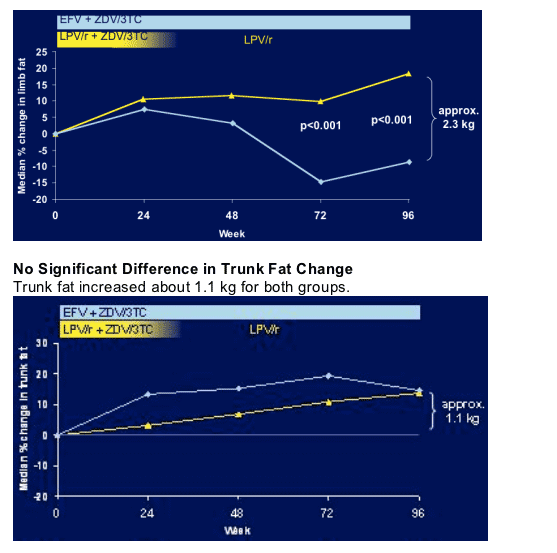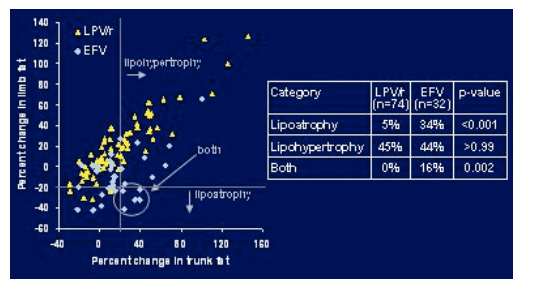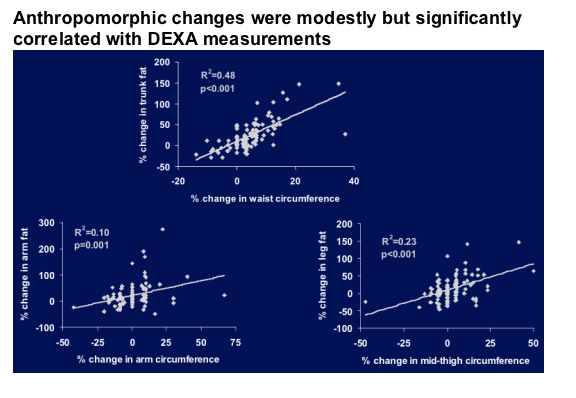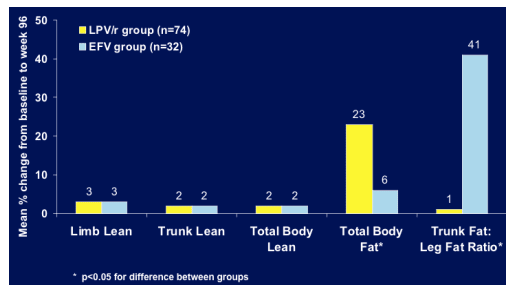 |
 |
 |
| |
Significant Sparing of Peripheral Lipoatrophy by HIV Treatment with LPV/r (Kaletra) + AZT/3TC Induction Followed by LPV/r Monotherapy Compared with EFV +AZT/3TC
|
| |
| |
Reported by Jules Levin
CROI, Feb 200, LA
Bill Cameron from Ottawa, Canada reported these study results in the oral Metabolics session Monday morning following the ACTG 5142 study results. The results from these 2 studies both reported lower rates of lipoatrophy for Kaletra than for efavirenz. These results were unexpected and stunned the attendees at this conference. There are 3 surpises, first that efavirenz was associated with such high rates of lipoatrophy in both ACTG 5142 and in this study, two, that Kaletra with 2 nukes showed such a better lipoatrophy profile than efavirenz with 2 nukes, and three, that Kaletra monotherapy showed no lipoatrophy in this study.
Summary of this study: after 96 weeks, 5% of patients on Kaletra monotherapy strategy (Kaletra+AZT/3TC who simplified after week 24 & 3 consecutive viral loads <50 c/ml) developed lipoatrophy compared to 34% taking EFV plus AZT/3TC (p<0.001). Lipohypertrophy was developed by both grouos, 45% for Kaletra, 44% for EFV/AZTR/3TC (p>0.99). Both lipoatrophy & lipohypertrophy was developed by 0% for Kaletra & 16% for EFV (p=0.002). Cameron summarized “there was significant sparing of peripheral fat loss and lipoatrophy for LPV/r monotherapy maintenance strategy, versus EFV + AZT/3TC. This could be due to reduced exposure to NRTIs, impact of EFV, impact of LPV/r, or a combination of all; although we reasonably suspect the nukes. This study was not designed to discover the reasons for the difference between the groups. Trunk fat increases & lipohypertrophy did not differ by HIV treatment. There is in my opinion likely clinical interaction between anabolic body mass increase due to therapy generally, and the defined lipodysmorphic changes of interest. That is, if you are skinny & you gain 20% body mass and a lot of that is fat you are going to reach a definition category of hypertrophy although there might not be dysmorphism attached to that. Anthropometric changes were modestly correlated with DEXA results. Although DEXA identifies body fat composition changes prior to reporting of adverse event, changes were becoming apparent by physical examination at 2 years". During the Q&A session Cameron commented on the potential reasons or mechanisms for these findings considering the ACTG 5142 results: “our prejudice would be to want to blame the AZT influence, it has been minimized but not eliminated from the Kaletra monotherapy group. It is not logically possible to parse out whether EFV itself may have a deleterious effect. We know that many of these drugs alter mitochondrial function and influence adipocyte apitosis which we think are involved in many of the metabolic changes we observe. So, I think its quite feasible that either EFV could have an effect or maybe there is a pharmacodynamic interaction between EFV and AZT that could account for this outcome. The fact that patients were weaned off AZT in the Kaletra group makes interactions doubly more complex and impossible to comment on, so we compare one strategy to another and we’ll have to leave understanding the mechanisms to another study".
However, I recall that results from ACTG 384 did not find lipoatrophy associated with efavirenz + AZT/3TC so the ACTG should provide an explanation.
STUDY DESIGN
104 ART-naive patients were randomized to Kaletra SGC 400/100mg bid plus AZT/3TC and 51 ART-naēve patients were randomized to Efavirenz 600mg QD plus AZT/3TC. After a minimum of 24 weeks on Kaletra + AZT/3TC patients who had 3 consecutive viral load measures <50 c/ml could simplify their regimen to Kaletra monotherapy. DEXA scans were used at baseline and every 24 weeks thereafter to evaluate changes in fat.
Antiviral Response and subject disposition for all Enrolled Subjects
Most patients remain successfully suppressed but you can see from the graph that more patients on Kaletra monotherapy had HIV viral loads between 50-500 and >500, and more patients on EFV had <50 c/ml.

Prevalence of lipoatrophy (>20% decrease in limb fat mass) and lipohypertrophy (>20% increase in trunk fat mass) at week 96 was compared between groups using Fisher’s exact test.
Baseline Characteristics
Subjects with week 96 DEXA scans
The characteristics were similar between the two grouos except that patients were 5 years older in the Kaletra arm (41 vs 34 yrs). Gender: 78% male.
Weight: 74-76 kg.
Limb fat: 8.2 kg in Kaletra, 7.4 kg EFV (mean)
Trunk fat: 9.3 kg Kaletra, 8.3 kg EFV (mean)
Race/Ethnicity:
Caucasian: 66% Kaletra, 66% EFV
Black: 26% Kaletra, 31% EFV
Hispanic: 5% Kaletra, 13% EFV
Other: 8% Kaletra, 3% EFV
Significant Difference in Limb Fat Change (ITT):
Patients on Kaletra did not show any decrease in limb fat during the Kaletra +AZR/3TC stage and during the Kaletra monotherapy stage. For patients on EFV there appears to be a steady decrease in limb fat after week 24 through week 96 following a 5-10% increase during the first 24 weeks. For patients on EFV there was a median decrease of 15% in limb fat at week 72 from baseline and about 10% at week 96.
You can see in the graph below that limb fat starts to decline for patients on EFV beginning at week 24 and continues to week 48. After week 48 the median % change in limb fat continues to decline in the EFV arm and at week 72 there is a statistically significant difference in limb fat between the EFV & Kaletra arms (p<0.001). There is also a statistically significant difference at week 96 (p<0.001). There is a slight increase in limb fat in the Kaletra arm that begins during the first 24 weeks (10%) and stabilizes during weeks 24 through 72, and then slightly increases during weeks 72 through 96 (another 5% increase for a total 15% increase from baseline to week 96). either during the first 24 48 weeks, nor during weeks 48 to 96. At week 96 there is an approximate 2.3 kg difference in limb fat between the Kaletra monotherapy arm & the EFV arm. Simplification to Kaletra monotherapy from Kaletra+AZT/3TC occurs during weeks 24-48.
The Kaletra monotherapy group includes 2 patients that did not de-intensify & 6 patients who re-added AZT/3TC.

Lipoatrophy and Lipohypertrophy
Of note, 5% in LPV/r group (n-74) developed lipoatrophy (defined as >20% loss of limb fat) compared to 34% of patients in EFV group (n=32) and the difference was statistically significant (p<0.001). Lipohypertrophy occurred for 45% in Kaletra arm & 44% in the EFV group (p>0.99. Both occurred for 16% of patients in EFV group and 0% in Kaletra group (p=0.002).

Baseline Parameters Associated With Limb or Trunk Fat Change
Baseline CD4 count was associated with limb fat changes. Subjects with low CD4 counts were more likely to have limb fat increases. After adjusting for CD4 count, the effect of treatment group remained significant, with more fat loss in the EFV group (p<0.001).
Baseline CD4 count was also associated with trunk fat changes: lower baseline CD4 counts resuktes in larger increases in trunk fat. After adjusting for CD4 count, effect of treatment group remained non-significant, with fat increase in each group. Cameron said “thin people with low CD4 counts had more fat to gain in the course of the healing effects of effective ART".
Other variables including demographics, lipids, TNF soluble receptors 1 and 2 levels were not associated with fat changes.
Cameron said, resukts did not change if different thresholds were used for lipoatrophy or lipohypertrophy (eg, 10% or 30% change).

Baseline to Week 96 Change in Other DEXA Variables
There was a 3% increase in limb lean mass in both groups; an increase of 2% in trunk lean mass in both groups; an increase in total body lean mass in both groups. Total body fat increased more markedly in the LPV group (23% vs 6%), which was the sum of the changes in the limb fat and trunk fat. The ratio of Trunk:Leg Fat was 1% for Kaletra to 41% for EFV.

|
| |
|
 |
 |
|
|